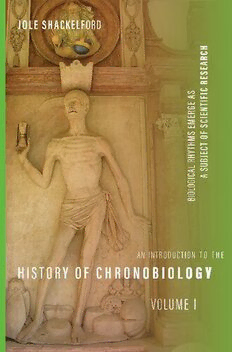
An Introduction to the History of Chronobiology, Volume 1: Biological Rhythms Emerge as a Subject of Scientific Research PDF
Preview An Introduction to the History of Chronobiology, Volume 1: Biological Rhythms Emerge as a Subject of Scientific Research
AN INTRODUCTION TO THE HISTORY OF CHRONOBIOLOGY VOLUME I Biological Rhythms Emerge as a Subject of Scientific Research H I ST OR Y O F C H R I E M U L O V JOLE SHACKELFORD a n i n t r o d u c t I o n t o t h e O NO B I O LO G Y H C R A E S E R C S I A F I E T G N R E E I M C E S S F M O H T T C Y E H J R B U L A S C A I G O L O I B University of Pittsburgh Press Published by the University of Pittsburgh Press, Pittsburgh, Pa., 15260 Copyright © 2022, University of Pittsburgh Press All rights reserved Manufactured in the United States of America Printed on acid- free paper 10 9 8 7 6 5 4 3 2 1 Cataloging-in-Publication data is available from the Library of Congress ISBN 13: 978-0-8229-4732-5 ISBN 10: 0-8229-4732-3 Cover art: This sculpture adorns a wall behind a grave in St. Sebastian’s Cemetery in Salzburg, Austria, home also for the remains of the famous sixteenth-century German physician and lay preacher Theophrastus Bombastus von Hohenheim, better known as Paracelsus. Photo by the author. Cover design: Joel W. Coggins IN MEMORIAM Franz Emanuel Halberg endocrinologist and chronobiologist July 5, 1919–June 9, 2013 Richard Max Shackelford geneticist and endocrinologist January 23, 1915–September 19, 2007 William Coleman historian of science and medicine July 2, 1934–April 28, 1988 CONTENTS Preface and Acknowledgments ix General Introduction 3 7 0 1 2 3 4 5 6 INTRODUCTION TO VOLUME I 27 1 RHYTHMIC PHENOMENA, MECHANICAL PHILOSOPHY, AND VITALISM IN ENLIGHTENMENT BIOLOGICAL SCIENCE 37 2 BIOLOGICAL RHYTHMS AND THE INTERNAL ENVIRONMENT 65 3 PHYSICOCHEMICAL REDUCTIONISM AND EXOGENOUS CAUSES OF PLANT RHYTHMS 86 4 INHERITED CAUSES OF DAILY RHYTHMS? 123 5 ENDOGENOUS RHYTHMICITY AND BIOLOGICAL CLOCKS 149 6 PHOTOPERIODISM AND BIRD MIGRATION 175 7 CYCLES AND RHYTHMS IN METABOLISM, DIGESTION, AND SPONTANEOUS ACTIVITY 202 CONCLUSION 233 7 0 1 2 3 4 5 6 Notes 239 Bibliography 283 Index 305 PREFACE AND AC KNOWLEDGMENTS MY interest in the history of chronobiology began unexpectedly in the autumn of 2008 with a telephone call from an elderly colleague at the Univer- sity of Minnesota. The voice was clear, and the articulation distinct, given an aura of clarity and precision by a hint of a German accent, or so it seemed to me at the time. The speaker wondered if he could use an image I had posted on my personal website, which depicted the Danish astronomer Tycho Brahe in conversation with the Italian astronomer Giovanni Battista Riccioli— a photograph of a mural detail on the ceiling of the Clementinum in Prague that I took on the occasion of the four- hundredth anniversary of Tycho’s death. I had studied Tycho Brahe’s scientific ideas and practices as part of my doctoral research and published several papers on his alchemical interest and was accordingly invited to participate in a conference on his life and work in the former imperial capital, where he had died in 1601. I was at home in Prague; a student of late medieval and early modern European science and medicine sharing ideas in one of Europe’s great centers for this history in my period of specialty. I could not have imagined then that this photograph would lead me to spend more than a decade immersed in the modern biology that lies behind the volumes of this current work. The path from early modern European science and medicine to nineteenth- and twentieth- century biology has led me into historiographical territory that my graduate training in the history of science and medicine did not specifically prepare me for and warrants some explanation, not least for younger colleagues who might balk at stepping off their own familiar paths to follow new guides. Tycho Brahe is well- known to historians of science for his place in the development of modern astronomy. Riccioli is less famous, but he is noted for his early investigation of sunspots. The image in the Clementinum is fanciful, since owing to their difference in age the two astronomers cannot possibly have met in real life, the painting being an emblem of the Counter- Reformation Catholic church’s resistance to Copernicus’s heliocentric plane- tary system. But this did not matter to the man on the phone. He said that he had looked in vain for a suitable image of Riccioli, which he wished to use for ix
